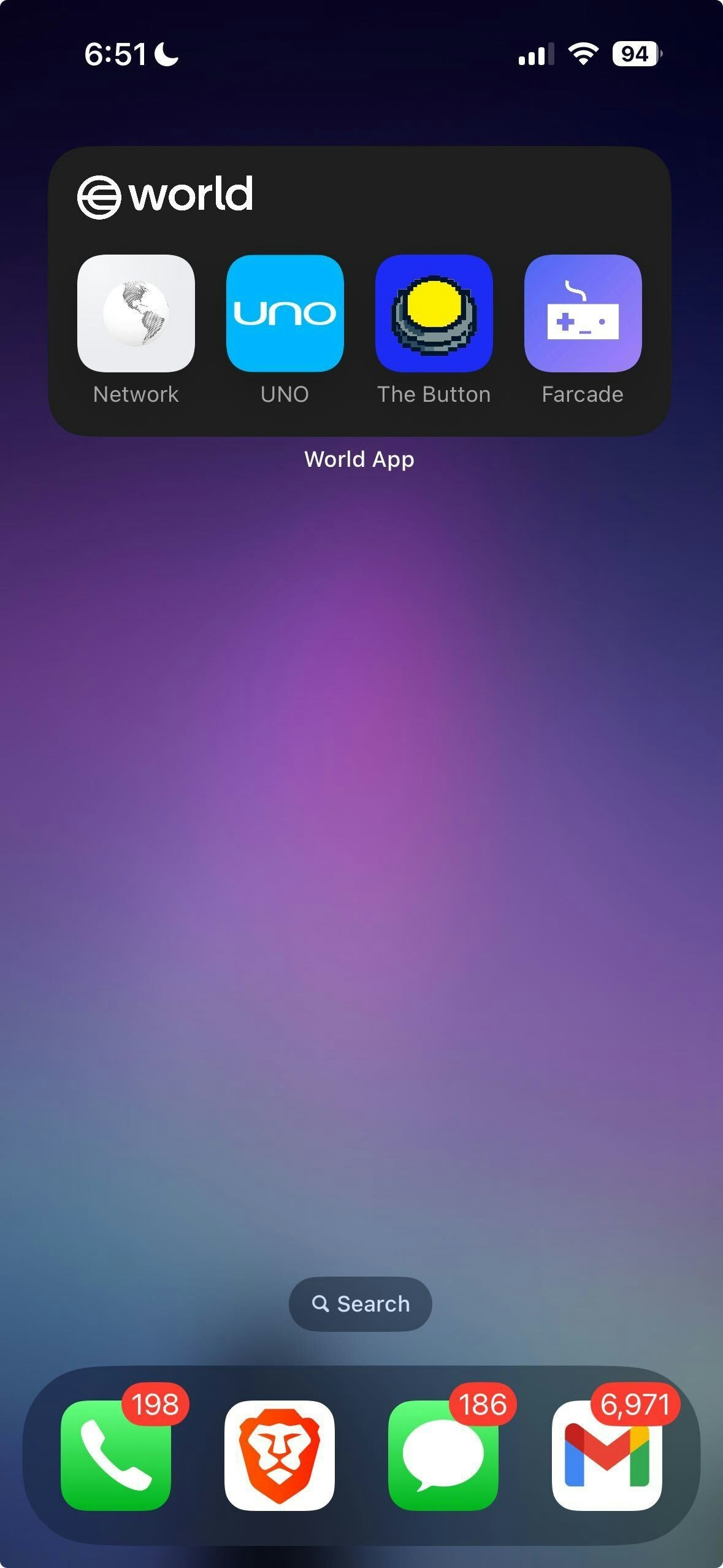Why It Works
Referral programs are proven growth drivers because they leverage trust. People are 4x more likely to try something recommended by a friend versus discovering it through ads. PayPal’s 20/20 referral program produced 7-10% daily growth, while Dropbox’s free storage rewards drove 3900% growth in 15 months.
Step-by-Step Implementation
1. Set Up Universal Links
Create server-side invite pages that work across all platforms:
// pages/invite.tsx
export default function InvitePage({ code }: { code: string }) {
useEffect(() => {
// Redirect to mini app
window.location.href = `https://world.org/mini-app?app_id=${YOUR_APP_ID}&path=/invite?code=${code}`
}, [code])
return <div>Redirecting to mini app...</div>
}
https://world.org/mini-app?app_id={app_id}&path={path}
Deep-link (opens World App directly if installed)
worldapp://mini-app?app_id={app_id}&path={path}
To force opening in the device browser instead of the native webview, append open_out_of_window=true to the URL (works for both universal and deep links).
Note: path should be URL encoded.
2. Generate Share Links
Create a shareable link that includes the referral information:
function generateInviteLink(userId: string): string {
const baseUrl = "https://world.org/mini-app";
const appId = "your_app_id";
const path = encodeURIComponent(`/invite?code=${userId}`);
return `${baseUrl}?app_id=${appId}&path=${path}`;
}
3. Implement Share Functionality
Add share buttons at key moments in your user journey:
import { MiniKit } from "@worldcoin/minikit-js";
async function shareInvite() {
const inviteLink = generateInviteLink(currentUser.id);
try {
await MiniKit.commandsAsync.share({
title: "Join me on [Your App Name]!",
text: `I'm using this amazing mini app. Join me and we both get rewards! 🎁`,
url: inviteLink,
});
// Track the share event
trackEvent("invite_link_created", {
user_id: currentUser.id,
share_method: "native",
});
} catch (error) {
console.error("Share failed:", error);
}
}
4. Handle Incoming Referrals
Process referral codes when new users sign up:
// On app initialization
function handleReferral() {
const urlParams = new URLSearchParams(window.location.search);
const refCode = urlParams.get("ref");
if (refCode && !currentUser.referredBy) {
// Credit the referrer
fetch("/api/process-referral", {
method: "POST",
headers: { "Content-Type": "application/json" },
body: JSON.stringify({
newUserId: currentUser.id,
referrerCode: refCode,
}),
});
}
}
5. Reward System
Implement two-sided rewards that benefit both parties:
// api/process-referral.ts
export async function processReferral(data: {
newUserId: string;
referrerCode: string;
}) {
const referrer = await getUserByCode(data.referrerCode);
if (!referrer) {
return { success: false, reason: "invalid_referrer" };
}
// Credit both users
await Promise.all([
creditUser(referrer.id, {
type: "referral_bonus",
amount: 100,
reason: "Friend joined via your invite",
}),
creditUser(data.newUserId, {
type: "signup_bonus",
amount: 50,
reason: "Welcome bonus for joining via invite",
}),
]);
return { success: true };
}
6. Support Deferred Deep Links (Android)
https://play.google.com/store/apps/details?id=com.worldcoin&referrer=app_id%3D{app_id}%26path%3D{path}
Optimising Social-Share Previews
World app universal links will forward the og:image from your integration url.
Eg. world.org/mini-app?app_id=1234&path=/invite?code=abcd will forward the og:image from [your-miniapp-url]/invite?code=abcd.
Inside World App Discovery
-
Quick Actions: Mini apps can hand off context to one another. Split distinct flows into focused apps that trigger each other with Quick Actions.
-
Widget: Your mini app can live on the phone’s home screen. Prompt the user to add the mini app as a widget in the home screen.
Widget on iOS
Design Best Practices
Placement Strategy
- After first value delivery: When user completes their first meaningful action
- Post-achievement: Right after earning a badge, completing a level, or winning
- Onboarding finale: As the last step of user setup
Copy That Converts
- Personal benefit first: “Get 100 coins for each friend who joins”
- Mutual benefit: “You both get rewards when they sign up”
- Social proof: “Join 10,000+ users already earning rewards”
Visual Design
- Use prominent, action-oriented buttons (“Invite Friends”, “Share & Earn”)
- Show potential rewards clearly with icons or progress bars
- Include preview of what the shared content looks like
Metrics to Track
Monitor these key events to measure your viral loop performance:
// Essential tracking events
const events = {
invite_link_created: { user_id, share_method },
invite_link_clicked: { ref_code, source },
signup_source_invite: { ref_code, new_user_id },
referral_reward_granted: { referrer_id, new_user_id, reward_amount },
};
Key Metrics Dashboard
- Invite Conversion Rate: (Signups from invites) / (Total invite links clicked)
- K-Factor: (New users from invites) / (Total active users)
- Viral Cycle Time: Average time from invite sent to new user activated
- Reward Cost per Acquisition: Total rewards paid / New users acquired
Quick A/B Test Ideas
Test these variables to optimize your viral loop:
- Reward Amount: Test 50 vs 100 vs 200 coin rewards
- Timing: Share prompt after first win vs after onboarding
- Copy: Personal benefit vs mutual benefit messaging
- Incentive Type: Coins vs premium features vs exclusive content
Start with small reward amounts and scale up based on unit economics. Cap
total lifetime rewards per user to control costs.
Next Steps
- Implement universal links for your invite flow
- Add share buttons after key user achievements
- Set up two-sided rewards with World ID verification
- Track invite metrics and run small A/B tests
- Scale successful invite mechanics across more touchpoints
